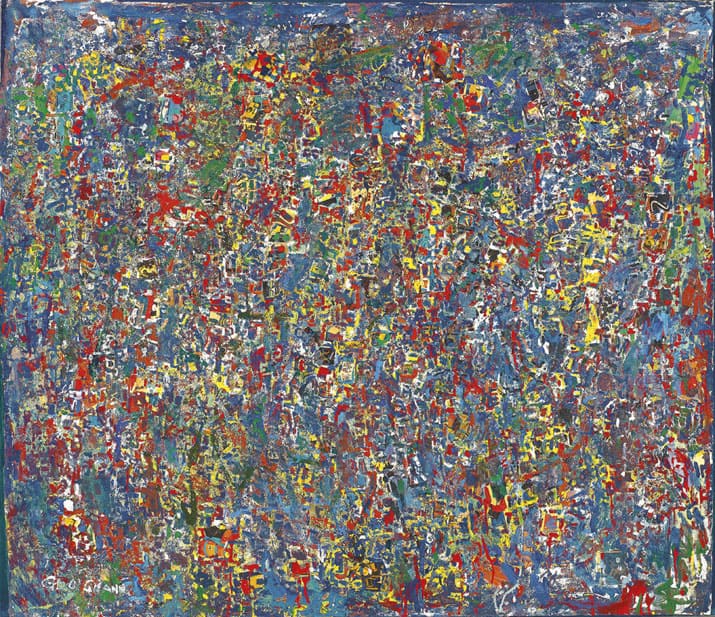
George Chann
George Chann Paintings For Sale
Click To Get A Valuation Of Your George Chann Painting. You’ll get a confidential fair market valuation of your painting and its marketability. We pay cash for paintings by George Chann and take consignments to the gallery.

Created by George Chann, 1987
Oil and painted paper collage on canvas
52 x 61 inches
GEORGE CHANN BIOGRAPHY
George Chann (Chinese/American, 1913-1995)
Artist George Chann (Chen Yinpi), was born in Zhongshan County, Guandong Province, China on Jan. 1, 1913. Chann and his father arrived in California as Chinese immigrants in 1922. George Chann lived in a missionary orphanage in Stockton, California and by the late 1920’s had moved to San Francisco. He lived in San Mateo from the early 1930’s. The most important decision of his life was to pursue an art career. Once decided, he moved to Los Angeles and began his studies at the Otis Art Institute (today the Los Angeles Art Institute) after having received a scholarship. He remained at the Otis Art Institute from 1934 to 1942.
During that time George exhibited his work in the California Art Club, 1941 (solo); The California Palace of the Legion of Honor, 1942, 1944 (solos); Los Angeles County Museum of Art, 1942 (solo), 1943; De Young Museum, 1944 (solo); Foundation of Western Art (Los Angeles), 1945, the San Diego Fine Arts Gallery and numerous others.
The artist excelled in his talent while studying under the great Edouard Vysekal and Alexander Brook. George Chann’s early artwork had its roots in the post-Impressionist movement. He created his own stylized landscapes and paintings of social-realism. These included character studies of ethnic peoples (Chinese, Blacks, and Mexicans) he must have encountered in his travels and living in Los Angeles. George Chann’s artwork would depict a strong humanitarian message and a deep compassion that would carry him throughout his lifetime.
One of his most dramatic paintings depicts the Los Angeles riots that surrounded the Rodney King incident and resulting fires. To show the power of emotions, George Chann merged representative and abstract styles. This was to be Chann’s last artwork in 1995.
George Chann Reviews
A whole variety of art critics from major news outlets took notice of George Chann’s enormous talent. Rollin McKinney, the Art Director of the Los Angeles County Museum of Art (LACMA), introduced George Chann’s artwork to many museums. This helped to open doors to some of his most notable shows. In fact, George Chann was the first Chinese artist to exhibit at the LACMA.
Alfred Frankenstein of the San Francisco Chronicle, critic Alexander Fried and Kay English, Art Directors of the San Francisco Examiner both wrote excellent reviews of George Chann artwork. These reviews came after attending Chann’s first show at the Palace of Legion of Honor (1942) and later shows in the San Francisco area (CPLH and De Young Museum both in 1944).
George Chann Exhibitions
George Chann art exhibitions in Los Angeles also garnered him many public admirers. Alma May Cook of the Los Angeles Herald Express followed his career and wrote several reviews about his talent. The great art critic, Arthur Miller of the Los Angeles Times, and later Howard Devere of the New York Times, both wrote one or more articles documenting Chann’s outstanding achievements. George Chann’s artwork appeared in national magazines like Art Digest Magazine, Art News, and Life Magazine. George Chann paintings were also represented in the Joan Ankrum Gallery and the Heritage Gallery (Los Angeles) from the 1960s through the 1980s. Because of the promotion of his work and the glowing reviews in the press, George Chann paintings began to sell to prominent collectors from Hollywood. This included the famous actor, Edward G. Robinson.
In 1947, George returned to China. He spent the next few years embracing his culture and incorporating his Asian culture into his artwork. While in Shanghai, he met his wife-to-be, Yvonne Chun. As the difficulties of the Communist takeover became more evident, the Chann’s left for Hong Kong in April 1949 where they married. Leaving behind their embattled home, the Chann’s returned to the United States. Their daughter, Janet, was born in San Francisco, CA in 1950.
George Chann Abstract Expressionism
After returning to the United States, George Chann realized that the Los Angeles art scene had changed. To reestablish himself in the art community he began exhibiting new works at the James Vigeveno Gallery. At this gallery, his artwork was very unique. The gallery exhibited American artists such as Grandma Moses and Paul Clemens, but focused upon European artists such as Van Gough, Renoir, Chagall and Rouault.
Comfortable with the abstract, George Chann began to integrate his Chinese heritage into the predominant artistic direction of the 1950’s, Abstract Expressionism. He took to this new style and began developing a combination of calligraphy and oils painted with precise individual strokes. Painting with one color and shape over another, George Chann often created collages of poetry painted on rice paper.
George Chann died in May, 1995 after enjoying a successful artistic career.
George Chann Retrospectives
Beginning in the year 2000, George Chann’s artwork and unique talent began a new trajectory. There was a major retrospective in Taipei, Taiwan. In 2005, another major retrospective of his abstract art was in Shanghai. In 2014, Christie’s Hong Kong initiated an effort to bring his genius to their Chinese collectors. This exhibit and sale was titled The Trajectory of George Chann. It shows his artistic development and his strong sales prices through the years.